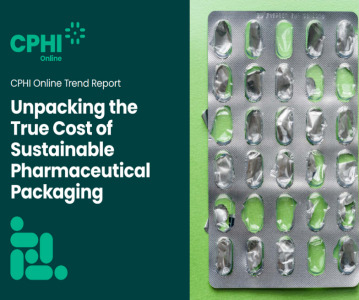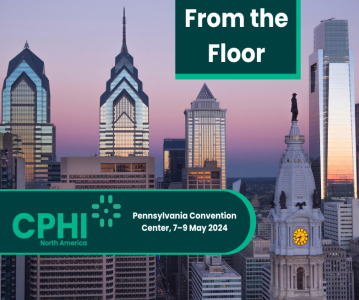How can pharma achieve ‘Net Zero’? Through driving change in pharma manufacturing

Through the entire product lifecycle – production, consumption and disposal – the pharma industry significantly impacts the environment.
As the industry gains a heightened awareness of its role in global emissions, many companies are setting ambitious targets to achieve carbon neutrality. Novartis has committed to achieving net zero across its value chain by 2040, as have Sanofi and GlaxoSmithKline by 2030.
There is much to be gained through reducing pharma’s ‘Environmental Factor’, as Girish Malhotra, President of EPCOT International, discussed in his recent blog post. Aside from the clear benefits to the environment, taking strides towards more sustainable practices will lower production costs, limit the burden of healthcare costs on authorities and protect public health.
So, where should pharma start?
According to Malhotra, API manufacturing and formulation companies have the greatest chance of meeting their climate goals by overhauling their manufacturing processes, though this presents its own set of challenges.
He suggests focusing on three core aspects: solvent reduction, yield improvement and efficient asset utilisation.
Three core pillars of green manufacturing
Solvent reduction
Pharmaceutical manufacturing is the most solvent-intensive of all chemical processes, and its reliance on solvents is commonly recognised as an environmental concern. These concerns generally relate to three areas: the source and synthesis of the solvent itself; its properties in use, including accidental discharge; and disposal.
By altering API manufacturing processes so that solvents are reduced and more waste solvents are recovered, companies stand a greater chance of reducing emissions and limiting ecological damage linked to discharge and disposal.
Yield improvement
When a process is improved to increase yield, waste is reduced and less solvents are required. Ultimately, yield improvement means the process is more efficient and fewer resources are required to achieve the end result - good news in terms of emissions.
Efficient asset utilisation
Efficient utilisation of assets not only reduces emissions from API manufacturing but lowers costs and ultimately makes the process more economically viable. Asset utilisation is closely linked with yield improvement and solvent reduction.
For example, making a process improvement that results in higher yield will not only reduce the number of solvents used, but also improve asset utilisation and batch cycle times. Whereas failing to iterate on existing methods will promote inefficiencies and poor asset utilisation.
Reaching ‘Net Zero’ - challenges to sustainable manufacturing
So how can API manufacturing and formulation companies reduce solvent use, improve yield and utilise their assets efficiently? According to Malhotra, sustainability needs to be considered at the onset of process development.
If pharmaceutical companies do not consider solvent reduction and yield improvement at the onset, it is extremely difficult for API manufacturers to do anything down the line.
For existing products, the biggest challenge to sustainability-focused process change lies in regulatory compliance. Overhauling the manufacturing process would require companies to seek regulatory reapproval for impacted products, which can be time-consuming and expensive. This presents a significant barrier to wide-spread, impactful change within the industry.
In a 2019 study looking at pharma emissions, the authors noted that process improvements are not an industry norm. They said the pharma industry has traditionally been ‘so profitable that it can afford to be extremely wasteful in its manufacturing processes’ and has ‘little economic incentive to optimise those high-footprint processes’.
Malhotra agrees. He says ‘nothing will change’ until API manufacturing and formulation processes are overhauled, but notes that issues like regulatory requirements, drug performance and cost are major blockers.
While pharma has been incentivised to take some strides towards ‘Net Zero’, it can be argued that the infrastructure (legal and financial) is not yet in place to propel industry-wide change in drug manufacturing.
Related News
-
News CPHI Milan 2024 - From the Floor
Milan and CPHI welcome you to 2024 CPHI Milan! As we celebrate the 35th edition of our flagship CPHI show, editors Vivian Xie and Lucy Chard bring you the latest from the show floor, conference sessions, and innovative solutions from all exhibitors, at... -
News CPHI Podcast Series: analysing supplier audits with the PSCI
This episode of the CPHI Podcast Series, hosted by Digital Editor Lucy Chard, goes through the results from the recent audits from the PSCI conducted on suppliers across the pharmaceutical industry, looking into ESG outcomes. -
News CPHI Online Trend Report: what is pharmaceutical packaging really costing the industry?
The latest CPHI Online Trend Report dives into what it really costs to develop, manufacture, and deploy pharmaceutical packaging that balances sustainability concerns, patient safety, and drug efficacy. -
News CPHI Podcast Series: the power of digital marketing in pharma
Digital marketing is a valuable tool for many industries, and the pharmaceutical and healthcare industry is no exception. The CPHI Podcast Series covers how marketing can be used by companies to increase their engagement and overcome challenges.&n... -
News Press release: CPHI Sustainability Report 2024 – a guide to a greener industry
The CPHI Pharma portfolio is pleased to announce that their annual Sustainability Report has been published, with thought leaders outlining a guide to a greener pharmaceutical industry. -
News The PSCI publishes Materiality Assessment of the Pharma Supply Chain
In the latest instalment of the PSCI blog on CPHI Online, The PSCI introduces the 2024 PSCI Supply Chain Materiality Assessment, the first public materialty assessment of the pharmaceutical supply chain they have worked on. -
News CPHI North America 2024 – From the Floor
Welcome to Philly! CPHI North America once again graces the Philadelphia Convention Center, 7–9 May 2024. -
News On Track at CPHI NA 2024: Sustainable Futures with Thermo Fisher Scientific
On the 7-9 May 2024 in Philadelphia, CPHI NA will be presenting an unmissable agenda, filled with content across 4 main tracks. In the following interview the Sustainable Futures Track sponsor, Thermo Fisher Scientific gives an overview of what to expe...
Position your company at the heart of the global Pharma industry with a CPHI Online membership
-
Your products and solutions visible to thousands of visitors within the largest Pharma marketplace
-
Generate high-quality, engaged leads for your business, all year round
-
Promote your business as the industry’s thought-leader by hosting your reports, brochures and videos within your profile
-
Your company’s profile boosted at all participating CPHI events
-
An easy-to-use platform with a detailed dashboard showing your leads and performance







